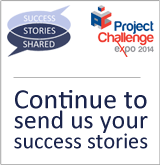
With increasing demands for efficiency in large national and international organisations, we are seeing more and more restructuring projects and programmes. These projects are critical to the success of internal restructuring programmes as well as mergers and acquisitions – badly done they are one of the major causes of poor return on investment and failed realisation of the anticipated benefits.
This Success Story Shared comes from the experiences of project manager LT. The aim of the restructuring programme, which LT headed up, was to create a single business for the continent that was completely aligned and integrated. Previous structures had all the countries on the continent operating in silos. The objective of the restructuring was to:
- Create a bank with a single identity in Africa, operating across 12 geographies;
- Allow for centralised operations with standard processes;
- Build co-ordinated systems thereby driving high levels of inter-operability and collaboration;
- Ensure a common and consistent customer experience ; and
- Prevent duplications within the country structures and encourage organisational effectiveness.
The financial services organisation retrenchment project 1 (ARP1) had been put on hold, but it was clear that the project would need to be re-started and that a new approach was essential.
The trouble was that ARP2 was likely to have even more difficult challenges. ARP1 had left staff and unions disillusioned and not trusting the intentions of the organisation and even more resistant to functional changes – relationships with key stakeholders were at an all time low. This was a high profile project and its failure to restructure the organisation and to align the organisation to global best practice, as well as the feeling of mistrust created across the company, was at risk of negatively impacting upon this financial services organisation’s reputation both locally and internationally (at the time of the restructuring, there had already been a merger between international and local entities) .
Moving back on course – righting a misdirected ship
When LT joined the team as the project manager she needed to identify what had gone wrong in ARP1, use these lessons learned to ensure that ARP2 was structured appropriately but additionally she must also deal with the “baggage” inherited from the previous project with respect to mistrust and reputational damage. She conducted one-on-ones with all the key stakeholders involved in the project to understand the nature of the problem in depth.
ARP1 had been led by the Head of HR for the area but it was clear from LT’s review that it had been conducted more as a business-as-usual initiative than as a project or programme. As she commented – “it was almost as if by putting a very senior person in charge it had been assumed that everything would just happen by virtue of seniority.” This was clearly not the case. The HR Executive who led this initiative was dismissed (a casualty of the process) because of the manner in which the project was mismanaged.
LTs first actions were to structure the project around a series of work-groups – get plans in place and clarify roles and responsibilities. She utilised the existing team members and based on her knowledge from the one-on-one discussions, set up teams who were commissioned and contracted with outcomes clearly defined. It was clear to LT that to be successful ARP2 had to be structured less around deadlines and more around the building of effective relationships. One key lesson in stakeholder management was to get senior managers to understand the importance of managing the process and rebuilding relationships as opposed to chasing project timelines.
Stakeholder engagement is key
Three key work groups were set up focusing on ensuring appropriate engagement with stakeholders utilising the right skills and levels of authority to ensure that stakeholder relationships could be facilitated (and in some cases repaired).
Team 1: Unions, external media and senior stakeholders within the organisation. It was important here to have people with excellent facilitation skills while at the same time ensuring that the appropriate levels of authority in the organisation were represented in this group. The unions in particular needed to be convinced that there was real commitment from senior management to work with them to make this work for all. Media releases had to be prepared and issued to ensure that communication was controlled and not left to the devices of snippets of gossip from various social media sites. Senior leadership in the organisation had to be kept up to speed (daily) to prevent them reading or hearing about this project via mainstream or social media sites.
Team 2: Focused on staff personal needs. This group included experts able to support people through the traumas associated with retrenchment. These were the original group of Human Resource professionals. The difference with approach ARP2 was that they were equipped with detailed plans on how to deal with the consultation process (each impacted staff was consulted and presented with the opportunity of applying for a related vacancy within the organisation; remaining on the retrenchment list or early retirements for those who qualified). During these consultations, professional psychologists were on hand to offer their services as and when required.
Team 3: Focused on policies, reward and remuneration – this group included specialists staff skilled and knowledgeable in the legal, reward (payroll), pension, medical aid and other HR considerations required by the impacted employees
Following consultation with the unions Team 4 emerged.
Team 4: focused on looking for opportunities for channelling vacancies and positions available in other parts of the financial services organisation into the project provided possibilities for employment of staff at risk of retrenchment.
Coordination of the inputs was through a 2-tier governance structure. The working committee consisted of selected representatives from the teams. This group had a key role in evaluating suggestions, taking into account across group perspectives and putting forward recommendations for actions to the steering committee and who ultimate decision making responsibilities.
ARP2 has been a success – a major accomplishment when you consider the additional challenges the projects had to face in taking over from ARP1.
Lessons learned
In summarising the lessons learned, LT highlights the following points:
Focus on stakeholder engagement strategies. This was a stakeholder-led project. It was more important to define a project that resulted in a successful stakeholder journey than a project simply focused on delivering a solution within pre-defined constraints
Be sensitive to stakeholder agendas and look for ways to optimise relationships and delivery. Team 4 focused on channelling vacancies back into the restructuring projects. This turned out to be a major win-win. The organisation management had listened to union’s concerns and showed evidence of putting real energy and commitment into finding solutions that benefitted everybody.
Governance is key, but it must not be isolated from the key concerns of the stakeholders. The working committee (and the selection of the representatives in this group) ensured that governance was grounded in the realities of the needs and demands of the organisation’s stakeholders across the group.
Business owners are experts in their respective areas and should not be appointed to manage projects merely because of their seniority. Projects must be managed by project managers. Period!
Project managers must understand that, for most people, change projects are very different to systems implementation projects. No amount of schedule compression or schedule crashing (throwing additional resources at the project or reducing the project schedule) will resolve the matter. People projects are about managing the process to successful conclusion and not to project deadlines.
What do you think?
For further information on the Success Stories Shared initiative click here.
If you would like to share your success story you can email info@citi.co.uk
For further stories you can also visit http://www.pi3.co.za/success-stories-shared and http://www.virtualprojectconsulting.com/success-stories-shared/









